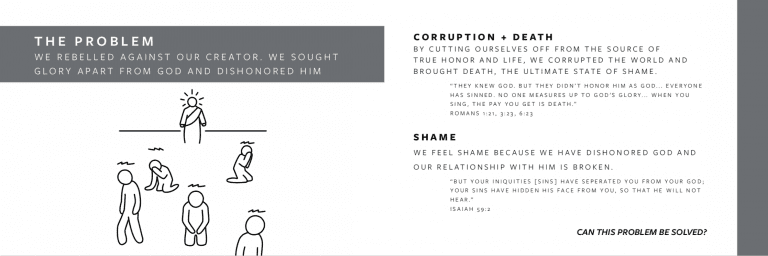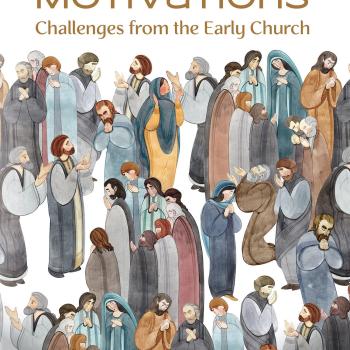Cru recently released an evangelism tract called “Honor Restored.” This new tool offers people an alternative to The Four Spiritual Laws. For people who live in honor-shame contexts, this presentation will make more sense.
You can find the tract on Cru’s evangelism app, GodTools. Download it from Apple’s App store at Google Play. So far, Honor Restored is translated into Arabic, Croatian, English, Hindi, Persian, Portuguese, and Turkish. It is also in the process of being translated into other languages, including Mandarin.
Why I like this tract
Bottom line –– this is a well-designed tract. Its theology is sound and the overall presentation thought-out. Now, let’s dig into the details.
Right away, the tract distinguishes shame from honor. It describes several facets of honor and shame that draw from the universal human experience.
Honor Restored is extremely clear. The presentation divides into five main sections.
- The Beginning
- The Problem
- The Solution
- Our Response
- The Result
The problem is well defined: “We rebelled against our creator. We sought glory apart from God and dishonored him.”
 It helpfully states death is the ultimate state of shame, a point often overlooked by many.
It helpfully states death is the ultimate state of shame, a point often overlooked by many.
The above picture demonstrates a wonderful aspect of this tract. Honor Restored keeps the community in mind. Instead of depicting the lone individual estranged from God, the art subtly shows our alienation from each other. Shame undermines all our relationships.
 Christ saves us, not merely me.
Christ saves us, not merely me.
As you’ll note, the developers mix familiar verses with passages less often found in evangelistic tracts. Pulling from both the NT and OT, users of Honor Restored have multiple options if they want to take friends and family to specific biblical texts.
 I love the various ways the tract describes our response. Rather than merely saying “faith,” which is so prone to misunderstanding, an array of phrases clarify what is a saving response to Christ. For example,
I love the various ways the tract describes our response. Rather than merely saying “faith,” which is so prone to misunderstanding, an array of phrases clarify what is a saving response to Christ. For example,
“We must turn away from seeking our honor and trust God”
“Complete trust”
“Embrace Jesus with complete loyalty and trust”
“Receive God’s honor”
What about “the prayer”?
Most tracts append a “prayer of salvation” to the end of its presentation. I’m not a fan of such prayers since they don’t, in fact, save people and even mislead people who think a formulaic prayer secures God’s blessing.
Well, Honor Restored includes something that resembles a “prayer of salvation.” But it ever so slightly differs from many other tracts. It never says that the prayer will save you. It simply invites people to use the prayer to “express the desire of your heart” to have God remove our shame and give us honor.
I’m glad for even this slight modification. Many people will overlook the omission. However, I hope they don’t misrepresent the prayer when using the tract with others in conversation.
 Sharing in Jesus’ Honor. Restored. Include. Honored. Simply beautiful.
Sharing in Jesus’ Honor. Restored. Include. Honored. Simply beautiful.
When the developer asked for feedback on this tool, we discussed the possibility of adding John 17:22 to this last page. However, some non-believers might be confused by Jesus praying to God his Father. And a conversation about the Trinity might not be the best opening. Fair enough. I like their choice of passages, especially Isaiah 61:3. So rich!
Nevertheless, I close this section with John 17:22 because it summarizes the above page so well. Jesus himself prays,
“The glory that you have given me I have given to them, that they may be one even as we are one.”
A Review of “Honor Restored”
A brief word is necessary to provide context for my comments. After looking at it, some people might be surprised with my endorsement. So, I’ll explain.
“Honor Restored” is an introduction to the gospel. Period. Like any tract, it can only do so much.
If you’ve read One Gospel for All Nations, you know the biblical writers consistently any of three major themes to frame their gospel presentations. They are creation, covenant, and kingdom. These framework themes are fundamental to the gospel. All other related images and motifs are explanatory themes (e.g., atonement, family, redemption, etc.), which highlight the significance of the gospel.
No, this tract does not emphasize Christ’s kingship. Nor does it touch on every aspect of an honor-shame perspective. But that was not the purpose of its designers.
No one, whether inside and outside of Cru, will not suddenly use this tract simply because it exists. Some workers are accustomed to The Four Spiritual Laws and other law-based presentations. They might even be suspect of anything that uses honor and shame. Therefore, the developers of Honor Restored produced an excellent tool people will be comfortable using yet without compromising by merely using superficial honor-shame language.
This tract will grab people’s attention. It is easy to use and will spur constructive gospel conversations. That’s reason to get excited.
Other evangelistic tools using honor and shame
You might be interested in a few other resources that use honor and shame to share the gospel. Here are a few examples.
The Promises of God (long version, short version)
Honor-Shame Reference Bookmark
The Father’s Love Gospel Booklet (based on Luke 15:11–32)
Do you want face? (video)
How does god seek “face”? (video)
Do you have questions, feedback, or suggestions for the developer of Honor Restored? Want to see it translated into a certain language? You can email Chris Sneller at csneller@gmail.com.
















